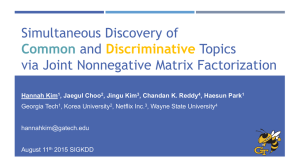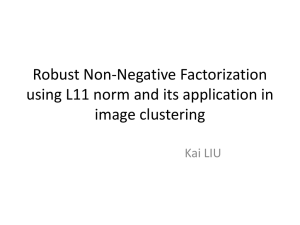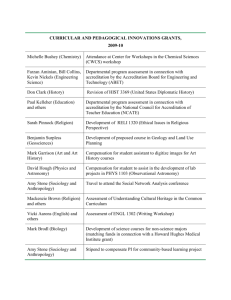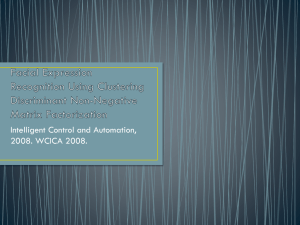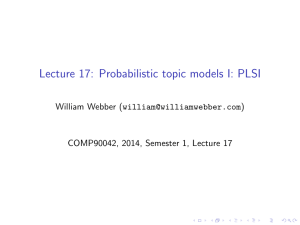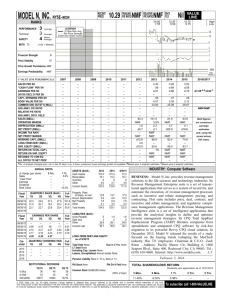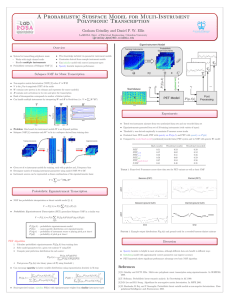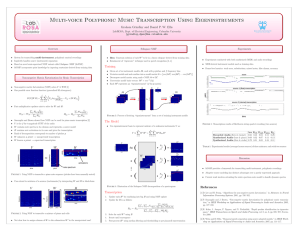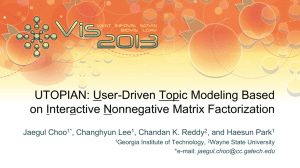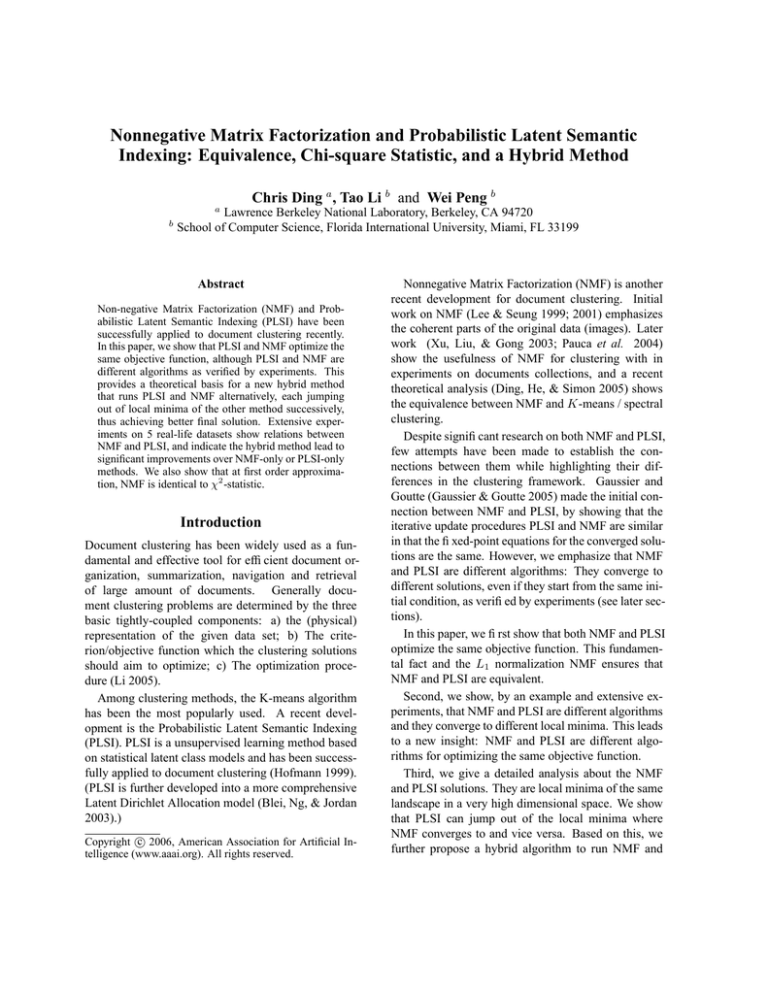
Nonnegative Matrix Factorization and Probabilistic Latent Semantic
Indexing: Equivalence, Chi-square Statistic, and a Hybrid Method
a
b
Chris Ding a , Tao Li b and Wei Peng b
Lawrence Berkeley National Laboratory, Berkeley, CA 94720
School of Computer Science, Florida International University, Miami, FL 33199
Abstract
Non-negative Matrix Factorization (NMF) and Probabilistic Latent Semantic Indexing (PLSI) have been
successfully applied to document clustering recently.
In this paper, we show that PLSI and NMF optimize the
same objective function, although PLSI and NMF are
different algorithms as verified by experiments. This
provides a theoretical basis for a new hybrid method
that runs PLSI and NMF alternatively, each jumping
out of local minima of the other method successively,
thus achieving better final solution. Extensive experiments on 5 real-life datasets show relations between
NMF and PLSI, and indicate the hybrid method lead to
significant improvements over NMF-only or PLSI-only
methods. We also show that at first order approximation, NMF is identical to χ2 -statistic.
Introduction
Document clustering has been widely used as a fundamental and effective tool for efficient document organization, summarization, navigation and retrieval
of large amount of documents. Generally document clustering problems are determined by the three
basic tightly-coupled components: a) the (physical)
representation of the given data set; b) The criterion/objective function which the clustering solutions
should aim to optimize; c) The optimization procedure (Li 2005).
Among clustering methods, the K-means algorithm
has been the most popularly used. A recent development is the Probabilistic Latent Semantic Indexing
(PLSI). PLSI is a unsupervised learning method based
on statistical latent class models and has been successfully applied to document clustering (Hofmann 1999).
(PLSI is further developed into a more comprehensive
Latent Dirichlet Allocation model (Blei, Ng, & Jordan
2003).)
c 2006, American Association for Artificial InCopyright °
telligence (www.aaai.org). All rights reserved.
Nonnegative Matrix Factorization (NMF) is another
recent development for document clustering. Initial
work on NMF (Lee & Seung 1999; 2001) emphasizes
the coherent parts of the original data (images). Later
work (Xu, Liu, & Gong 2003; Pauca et al. 2004)
show the usefulness of NMF for clustering with in
experiments on documents collections, and a recent
theoretical analysis (Ding, He, & Simon 2005) shows
the equivalence between NMF and K-means / spectral
clustering.
Despite significant research on both NMF and PLSI,
few attempts have been made to establish the connections between them while highlighting their differences in the clustering framework. Gaussier and
Goutte (Gaussier & Goutte 2005) made the initial connection between NMF and PLSI, by showing that the
iterative update procedures PLSI and NMF are similar
in that the fixed-point equations for the converged solutions are the same. However, we emphasize that NMF
and PLSI are different algorithms: They converge to
different solutions, even if they start from the same initial condition, as verified by experiments (see later sections).
In this paper, we first show that both NMF and PLSI
optimize the same objective function. This fundamental fact and the L1 normalization NMF ensures that
NMF and PLSI are equivalent.
Second, we show, by an example and extensive experiments, that NMF and PLSI are different algorithms
and they converge to different local minima. This leads
to a new insight: NMF and PLSI are different algorithms for optimizing the same objective function.
Third, we give a detailed analysis about the NMF
and PLSI solutions. They are local minima of the same
landscape in a very high dimensional space. We show
that PLSI can jump out of the local minima where
NMF converges to and vice versa. Based on this, we
further propose a hybrid algorithm to run NMF and
PLSI alternatively to jump out a series of local minima
and finally reach to a much better minimum. Extensive experiments show this hybrid algorithm improves
significantly over the standard NMF-only or PLSI-only
algorithms.
Data Representations of NMF and PLSI
Suppose we have n documents and m words (terms).
Let F = (Fij ) be the word-to-document matrix: Fij =
F (wi , dj ) is the frequency of word wi in document dj .
In this paper, we re-scale the term
P frequency Fij
by Fij ← Fij /Tw , where Tw =
ij Fij is the total number
of
words.
With
this
stochastic
normalizaP
tion, ij Fij = 1. The joint occurrence probability
p(wi , dj ) = Fij .
The general form of NMF is
F = CH T ,
(1)
where the matrices C = (Cik ), H = (Hjk ) are nonnegative matrices. They are determined by minimizing
JNMF =
m X
n
X
Fij log
i=1 j=1
Fij
− Fij + (CH T )ij (2)
(CH T )ij
PLSI maximize the likelihood
max JPLSI ,
JPLSI =
m X
n
X
Fij logP (wi , dj )
(3)
i=1 j=1
k
where the probability factors follow the normalization
of probabilities
i=1
p(wi |zk ) = 1,
n
X
p(dj |zk ) = 1,
j=1
Proof of Theorem 1: By Proposition 2, NMF (with
L1 -normalization, see §3) is identical to PLSI factorization. By Proposition 1, they minimize the same objective function. Therefore, NMF is identical to PLSI.
u
–
We proceed to prove Proposition 1 in this section.
Proof of Proposition 1:
First, we note that the
PLSI
Eq.(3) can
Pm
Poptimization
n
be written as
min i=1 j=1 −Fij logP (wi , dj ).
Pm Pn
Adding a constant,
i=1
j=1 Fij logFij , PLSI is
equivalent to solve
n
m X
X
Fij
.
Fij log
min
P
(w
i , dj )
i=1 j=1
Now since
n
m X
X
we can add this constant to the summation; PLSI is
equivalent to minimize
n
m X
X
Fij
Fij log
− Fij + P (wi , dj ) (7)
P
(w
i , dj )
i=1 j=1
K
X
|(CH T )ij − Fij |
Fij
is small; We can write
z=
p(zk ) = 1. (5)
k=1
Equivalence of NMF and PLSI
(8)
Theorem 1. PLSI and NMF are equivalent.
The proof is better described by the following
«
„
2
3
1 δij
1 δij
δij
−
=
+ ··· ,
δij − Fij log 1 +
Fij
2 Fij
3 Fij2
Proposition 1. The objective function of PLSI is identical to the objective function of NMF, i.e.,
min JNMF
n
m X
X
[(CH T )ij − Fij ]2 [(CH T )ij − Fij ]3
−
+· · · ,
2Fij
3Fij2
i=1 j=1
This is obtained by setting δij = (CH T )ij − Fij ,
z = δij /Fij , and log(1 + z) = z − z 2 /2 + z 3 /3 · · · ;
then the ij-th term in JNMF becomes
In this section, we present our main results:
⇐⇒
u
–
NMF and χ2 -statistic.
JNMF of Eq.(2) has a somewhat complicated expression. It is related to the Kullback-Leibler divergence.
We give a better understanding by relating it to the familiar χ2 test in statistics. Since we approximate Fij
by (CH T )ij , we may assume
JNMF =
max JPLSI
[P (wi , dj ) − Fij ] = [1 − 1] = 0,
i=1 j=1
This is precisely the objective function for NMF.
where P (wi , dj ) is the factorized (i.e., parameterized
or approximated ) joint occurrence probability
X
P (wi , dj ) =
p(wi |zk )p(zk )p(dj |zk ), (4)
m
X
Proposition 2. Column normalized NMF of Eq.(1)
is equivalent to the probability factorization of Eq.(4),
i.e., (CH T )ij = P (wi , dj ).
(6)
which gives Eq.(8). Clearly, the first term in JNMF is
the χ2 statistic,
χ2 =
m X
n
X
[(CH T )ij − Fij ]2
,
Fij
i=1 j=1
(9)
since Fij is the data and (CH T )ij is the model fit to it.
Therefore, to first order approximation, NMF objective
function is a χ2 statistic. As a consequence, we can
assoicate a confidence to NMF factoriztion. following
χ2 statistic.
The χ2 form of NMF naturally relates to another
NMF cost function, i.e., the sum of squared errors
0
JNMF
=
m X
n
X
[Fij −(CH T )ij ]2 = ||F −CH T ||2F . (10)
i=1 j=1
In this form, NMF is closely related to K-means clustering (Ding, He, & Simon 2005). Let the columns of
C, F be
C = (c1 , . . . , ck ), H = (h1 , . . . , hk ).
(11)
We interprete ck as the centroid for k-th cluster, while
hk = {0, 1} as the cluster indicator. The standard Kmeans clustering objective can be written as
JK -means =
n X
K
X
hik ||xi − ck ||2 = ||X − CH T ||2 ,
i=1 k=1
where X = (x1 , . . . , xn ) are documents. In most
cases, the strict condition hk = {0, 1} is not imposed;
thus hjk becomes the posterior probability for document dj belonging to the k-th cluster.
Both PLSI and K-means are widely used for document clustering. A comprehensive comparison among
0
forms of NMF would be useful, but
JNMF , χ2 and JNMF
goes beyond the scope of this paper.
Normalizations of NMF
For any given NMF solution (C, H), there exist a
large number of matrices (A, B) such that AB T =
I, CA ≥ 0, HB ≥ 0.. Thus (CA, HB) is also a
solution with the same cost function value. Normalization is a way to eliminate this uncertainty. We mostly
consider the normalization of columns of C, H. Let
the normalized columns be
e1, . . . , h
e k ).
C̃ = (e
c1 , . . . , e
ck ), H̃ = (h
(12)
With this normalization, we can write
e H ,
CH = CS
T
eT
where
e = CD −1 , H
e = HD −1 , S = DC DH .
C
C
H
(14)
e k ||p .
(DH )kk = ||h
For the standard Euclidean distance normalization, i.e.,
the L2 -norm
||e
ck ||2 = 1,
e k ||2 = 1,
||h
Due to the non-negativity, these are just the condition
that columns sums to 1. DC contains the column sums
of C and DH contains the column sums of H.
With these clarifications, we prove Proposition 2.
Proof of Proposition 2:
Using L1 -norm, we obviously have
m
n
n
X
X
X
e
e
Cik = 1,
Skk = 1,
Hjk = 1,
i=1
j=1
(15)
k=1
where the last equality is proved as
1=
X
Fij =
n
K X
m X
X
i=1 k=1 j=1
ij
e ik Skk H
e jk =
C
K
X
Skk .
k=1
These can be seen as equivalent to the normalization
e ik = p(wi |zk )
of probabilities of Eq.(5). Therefore, C
e
, Hjk = p(dj |zk ) and Skk = p(zk ) . Thus F =
e H
e T factorization with L1 -normalization
CH T = CS
is identical to PLSI factorization
u
–
An Illustration of NMF/PLSI Difference
Although NMF and PLSI optimize the same objective
function as shown above, they are different computational algorithms. This fact is obvious from experiments. In all of our extensive experiments, starting
with the same initial starting C0 , H0 , NMF and PLSI
always converge to different solutions. Here we give
an illustration. The input data matrix is
0
.048
B.035
B
X = B.031
@.027
.047
.042
.040
.019
.023
.043
.047
.045
.031
.031
.035
.024
.016
.040
.032
.026
.029
.023
.045
.039
.021
The initial C0 , S0 , H0 are
(13)
DC , DH are diagonal matrices. Depending on the normalizations in the Hilbert space, the Lp -normalization,
the diagonal elements are given by
(DC )kk = ||e
ck ||p ,
This is the same as in singular value decomposition
where the non-negativity constraint is ignored.
For probabilistic formulations, such as PLSI, we use
the L1 norm.
e k ||1 = 1,
||e
ck ||1 = 1, ||h
(16)
C0 S0 H0T
0
.24
B.02
B
= B.31
@.07
.36
1
.20
.27C „
C .34
.16C
0
.26A
.11
0
.18
.15
«B
B
0 B.15
.66 B
B.18
@.18
.16
1
.026
.029C
C
.042C .
.045A
.019
1T
.19
.18C
C
.21C
.12C
C
.14A
.16
Running NMF starting from (C0 , S0 , H0 ), the converged solution are
C̃S H̃ T
0
.33
B.29
B
= B.02
@.05
.32
1
.14
.12C „
C .39
.33C
0
.29A
.11
0
.27
.28
«B
B
0 B.25
.61 B
B.07
@.06
.06
1T
.14
.09C
C
.15C
.
.18C
C
A
.22
.23
Running PLSI starting from (C0 , S0 , H0 ), the converged solution are
CSH T
0
.12
B.10
B
= B.38
@.33
.08
0
.13
.09
«B
B
0 B.14
.50 B
B.19
@.22
.23
1
.31
.28C „
C .50
.04C
0
.07A
.31
1T
.25
.25C
C
.24C
.
.09C
C
A
.09
.09
One can see NMF solution differs from PLSI solution significantly. Our example shows that starting at
the same point in the multi-dimensional space, NMF
and PLSI converge to different local minima.
However, it is interesting and important to note that
the clustering results embedded in the solutions of
NMF and PLSI are identical by an examination of H
(see footnote 2): the first 3 data points (columns) belong to one cluster, and the rest 3 points belong to another cluster. This result is the same as the K-means
clustering. More generally, we introduce a clustering
matrix R = (rij ), where rij = 1 if xi , xj belong to
the same cluster; rij = 0 otherwise. Thus the clustering results can be expressed as
0
RNMF = RPLSI
1
B1
B
B1
=B
B0
@0
0
1
1
1
0
0
0
1
1
1
0
0
0
0
0
0
1
1
1
0
0
0
1
1
1
1
0
0C
C
0C
1C
C
1A
1
(17)
Comparison between NMF and PLSI
In this section, we compare the clustering performance
of each methods on 5 real-life datasets.
Datasets
We use 5 datasets in our experiments, most of which
are frequently used in the information retrieval research. Table 1 summarizes the characteristics of the
datasets.
Datasets
CSTR
WebKB
Log
Reuters
WebAce
# documents
476
4199
1367
2900
2340
WebKB The dataset contains webpages gathered
from university computer science departments. There
are about 4199 documents and they are divided into 4
categories: student, faculty, course, project.
Log This dataset contains 1367 log text messages
which are grouped into 9 categories, i.e., configuration,
connection, create, dependency, other, report, request,
start, and stop.
Reuters The Reuters-21578 Text Categorization
Test collection contains documents collected from the
Reuters newswire in 1987. In our experiments, we use
a subset of the data collection which includes the 10
most frequent categories among the 135 topics and has
about 2900 documents.
WebAce
The dataset is from WebACE
project (Han et al. 1998). It contains 2340 documents consisting news articles from Reuters new
service via the Web in October 1997. These documents
are divided into 20 classes.
To pre-process the datasets, we remove the stop
words using a standard stop list. All HTML tags are
skipped and all header fields except subject and organization of the posted articles are ignored. In all our
experiments, we first select the top 1000 words by mutual information with class labels.
# class
4
4
9
10
20
Table 1: Dataset Descriptions.
CSTR The dataset contains the abstracts of technical reports (TRs) published in the Computer Science
Department at the University of Rochester between
1991 and 2002. The dataset has 476 abstracts, which
are divided into four research areas: Natural Language
Processing(NLP), Robotics/Vision, Systems, and Theory.
Evaluation Measures
The above document datasets are standard labeled corpora widely used in the information retrieval literature. We view the labels of the datasets as the objective
knowledge on the structure of the datasets. To measure
the clustering performance, we use accuracy, entropy,
purity and Adjusted Rand Index (ARI) as our performance measures. We expect these measures would
provide us with good insights.
Accuracy discovers the one-to-one relationship between clusters and classes and measures the extent to
which each cluster contained data points from the corresponding class. It sums up the whole matching degree between all pair class-clusters. Accuracy can be
represented as:
X
T (Ck , Lm ))/N, (18)
Accuracy = M ax(
Ck ,Lm
where Ck denotes the k-th cluster, and Lm is the mth class. T (Ck , Lm ) is the number of entities which
belong to class m are assigned to cluster k. Accuracy computes the maximum sum of T (Ck , Lm ) for
all pairs of clusters and classes, and these pairs have no
overlaps. The greater accuracy means the better clustering performance.
Purity measures the extent to which each cluster
contained data points from primarily one class. In
general, the larger the values of purity, the better the
clustering solution is. Entropy measures how classes
distributed on various clusters. Generally, the smaller
the entropy value, the better the clustering quality is.
More details on the purity and entropy measures can
be found in (Zhao & Karypis 2004).
The Rand Index is defined as the number of pairs
of objects which are both located in the same cluster
and the same class, or both in different clusters and
different classes, divided by the total number of objects (WM 1971). Adjusted Rand Index which adjusts
Rand Index is set between [0, 1] (GW & MC 1986).
The higher the Adjusted Rand Index, the more resemblance between the clustering results and the labels.
(a) Purity
(b) Entropy
terms of purity value, the differences between the clustering solutions obtained by NMF and PLSI are less
than 0.02 in all the datasets. We can observe similar
behavior for other performance measures as well 1 .
Agreements Between NMF and PLSI
However, the closeness of NMF and PLSI on these
four performance measures merely indicates the level
of agreement between the NMF clustering solution and
the known class label information is close to the level
of agreement between PLSI and known class labels.
To understanding the difference between NMF and
PLSI, we compare NMF and PLSI solutions directly:
We measure the number of difference in clustering of
data pairs using the clustering matrix R in Eq.(17). To
normalize the difference so that datasets of different
sizes can be compared with, we measure the relative
difference:
.q
δ = ||RNMF − RPLSI ||F
||RNMF ||2F /2 + ||RPLSI ||2F /2
The computed results, the average of 10 different
runs, are listed in line A of Table 2. The results show
that the differences between NMF and PLSI are quite
substantial for WebKB (24%), and ranges between 1%
to 8% in general cases.
(c) Accuracy
(d) Adjust Rand Index
Figure 1: Performance Comparison of NMF and PLSI
Performance Comparison
For each of the five datasets we first run K-means clustering. This serves as a comparison and also initialization. From the K-means solution, H0 is constructed
from the cluster assignments and C0 is simple the cluster centroids (see footnote 2). The H0 obtained this
way is discrete (0 and 1) and is very sparse (mostly
zeroes). This is generally poor for multiplicative updation algorithms. Thus we smooth H0 by adding 0.2
to every elements of H0 . We then do necessary normalization on C0 , H0 . Starting from this smoothed Kmeans solution, we run NMF or PLSI. From the NMF
or PLSI solution, we harden the posterior H (see footnote 2) to obtain a discrete H (containing 0 and 1).
From here, the performance measures are computed.
We typically run 10 runs and obtain the average.
The clustering solutions of NMF and PLSI are compared based on accuracy, entropy, purity, and Adjust
Rand Index as shown in Figure 1. From these figures,
we observe that NMF and PLSI lead to similar clustering results. For example, as shown in Figure 1(a), in
A
B
C
WebAce
0.083
0.029
0.022
CSTR
0.072
0.025
0.013
WebKB
0.239
0.056
0.052
Reuters
0.070
0.051
0.040
Log
0.010
0.010
0.012
Table 2: Dis-agreements between NMF and PLSI. All
3 type experiments begin with the same smoothed Kmeans. (A) Smoothed K-means to NMF. Smoothed
K-means to PLSI. (B) Smoothed K-means to NMF to
PLSI. (C) Smoothed K-means to PLSI to NMF.
Function JNMF defines a surface in the multidimensional space. Because this global objective function is not a convex function, there are in general
a very large number of local minima in the high pdimensional space. Our experimental results suggest
that starting with same initial smoothed K-means solution, NMF and PLSI converge to different local minima. In many cases, NMF and PLSI converge to
nearby local minima; In other cases they converge to
not-so-nearby local minima.
1
One thing we need to point out is that, in terms of accuracy, NMF and PLSI have a large difference of about 0.2 on
WebKB dataset. This is because WebKB contain a lot of confusing webpages that can be assigned to one or more clusters
and the accuracy measure takes into account the entire distribution of the documents in a particular cluster and not just
the largest class as in the computation of the purity.
Summary
A Hybrid NMF-PLSI Algorithm
We have seen that NMF and PLSI optimize the same
objective function, but their different detailed algorithms converge to different local minima. An interesting question arises. Starting from a local minimum
of NMF, could we jump out the local minimum by running the PLSI algorithm? Strictly speaking, if an algorithm makes an infinitesimal step, it will not jump out
of a local minimum (we ignore the situation that the
minimum could be saddle points). But PLSI algorithm
is a finite-step algorithm, so it is possible to jump out
of a local minimum reached by NMF. Vise versa, NMF
is also a finite-step algorithm.
Interestingly, experiments indicate we can jump out
of local minima this way. The results are shown in
Table 2 Lines B & C. In Line B, we start from the Kmeans solution with smoothing and converge to a local minimum using NMF. Starting from the same local
minimum, we run PLSI till convergence. The solution
changed and the difference is given in Line B. This
change indicates that we jump out of the local minimum. The changes in the solutions are smaller than
Line A, as expected. In Line C, we start from the Kmeans solution with smoothing and then run PLSI to
converge to a local minimum; we then jump out of this
local minimum by running NMF. The difference of the
solutions is given in Line C. The changes in the solutions are smaller than line A, as expected. The changes
are also smaller than line B, indicating the local minimum reached by PLSI is perhaps slightly deeper than
the local minima reached by NMF.
Based on the ability of NMF for jumping out of local
minima of PLSI and vise versa, we propose a hybrid
algorithm that alternatively runs NMF and PLSI, with
the goal of successive jumping out local minima and
therefore converging to a better minimum. The hybrid
algorithm consists of 2 steps (1) K-means and smooth.
(2) Iterate till converge: (2a) Run NMF to converge.
and (2b) Run PLSI to converge. We run the hybrid
algorithm on all 5 datasets. The results are listed in
Table 3. We observe that: (1) NMF and PLSI always
improve upon K-means. (2) Hybrid always improve
upon NMF and PLSI; the improvements are significant
on 3 out of 5 datasets.
A
B
C
D
Reuters
0.316
0.454
0.487
0.521
WebKB
0.410
0.619
0.510
0.644
CSTR
0.617
0.666
0.668
0.878
WebAce
0.416
0.520
0.519
0.523
Log
0.775
0.778
0.779
0.781
Table 3: Clustering Accuracy. (A) K-means. (B)
NMF-only. (C) PLSI-only. (D) Hybrid.
In this paper we show that NMF and PLSI optimize
the same objective function. Based on this analysis,
we propose a hybrid algorithm which alternatively runs
NMF and PLSI. Extensive experiments on 5 datasets
show the significant improvement of the hybrid method
over PLSI or NMF.
Acknowledgment. Chris Ding is partially supported
by the US Dept of Energy, Office of Science. Tao Li
is partially supported by a 2005 IBM Faculty Award, a
2005 IBM Shared University Research (SUR) Award,
and the NSF grant IIS-0546280. Wei Peng is supported by a Florida International University Presidential Graduate Fellowship.
References
Blei, D.; Ng, A.; and Jordan, M. 2003. Latent dirichlet allocation. Journal of Machine Learning Research 3:9931022.
Ding, C.; He, X.; and Simon, H. 2005. On the equivalence
of nonnegative matrix factorization and spectral clustering.
Proc. SIAM Data Mining Conf 2005.
Gaussier, E., and Goutte, C. 2005. Relation between plsa
and nmf and implications. In Proc. ACM SIGIR conference on Research and development in information retrieval,
601–602. New York, NY, USA: ACM Press.
Milligan, GW, and Cooper, MC. 1986. A study of the comparability of external criteria for hierarchical cluster analysis. Multivar Behav Res 21:846–850.
Han, E.-H.; Boley, D.; Gini, M.; Gross, R.; Hastings, K.;
Karypis, G.; Kumar, V.; Mobasher, B.; and Moore, J. 1998.
WebACE: A web agent for document categorization and
exploration. In Proc. Int’l Conf. on Autonomous Agents
(Agents’98). ACM Press.
Hofmann, T. 1999. Probabilistic latent semantic analysis.
In Proc. ACM SIGIR conference .
Lee, D., and Seung, H. S. 1999. Learning the parts of objects by non-negative matrix factorization. Nature 401:788–
791.
Lee, D., and Seung, H. S. 2001. Algorithms for nonnegatvie matrix factorization. Advances in Neural Information Processing Systems 13.
Li, T. 2005. A general model for clustering binary data. In
KDD, 188–197.
Pauca, V. P.; Shahnaz, F.; Berry, M.; and Plemmons, R.
2004. Text mining using non-negative matrix factorization.
In Proc. SIAM Int’l conf on Data Mining (SDM 2004), 452–
456.
Rand, W.M. 1971. Objective criteria for the evaluation of
clustering methods. J Am Stat Assoc 66:846–850.
Xu, W.; Liu, X.; and Gong, Y. 2003. Document clustering
based on non-negative matrix factorization. In Proc. ACM
Conf. Research development in IR(SIRGIR), 267–273.
Zhao, Y., and Karypis, G. 2004. Empirical and theoretical
comparisons of selected criterion functions for document
clustering. Machine Learning 55(3):311–331.

